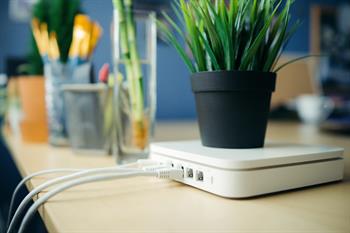WiFi Optimization: Getting the Most from Your Home Network | GVTC
Managing to get a wireless signal into every corner of your home can be challenging. This is especially true if you own a bigger home or your house has thick walls. Don't fret though; there are a few steps you can take to improve the coverage of your wireless network and improve performance as well. The beautiful part is that none of these will cost you anything other than a little bit of your time.
Why Your Network is Slow
Before we get into how to optimize your network, let's talk about why it might be running slow. Physical barriers can cause interference with the wireless signals in your home, and the distance between your router and your devices doesn't help either. Something as simple as putting your router on a shelf or mantle can improve the performance of your wireless network.
Typically three things have a direct impact
- Router placement on the speed of your wireless network:
- Technology capabilities or limitations
- Connected devices
Router Placement
 Speaking of device placement, where you put your wireless router is perhaps the most important decision you'll make in relation to your wireless network. Some people prefer to put it in an upstairs office or hide it away in the attic or the basement. Putting the router in these types of places make it difficult for the network to reach your entire home. Instead, find a central location, preferably on the top (or highest) floor of your home, so that the network is evenly distributed.
Speaking of device placement, where you put your wireless router is perhaps the most important decision you'll make in relation to your wireless network. Some people prefer to put it in an upstairs office or hide it away in the attic or the basement. Putting the router in these types of places make it difficult for the network to reach your entire home. Instead, find a central location, preferably on the top (or highest) floor of your home, so that the network is evenly distributed.
Of course, it's not always easy to find the ideal location for your router, especially since most jacks are drilled through into one of the corners of your home. Do what you can to get the router raised up off the floor so the signal can disseminate through your home. Keep in mind that closet doors, metal structures, and obstacles can all interfere with your wireless signal.
Security Settings
Many of today's WiFi routers come with a network name (SSID) and password (Encryption Key) already set up. It's important that you change these so no one else has access to your network. However, when you do so, remember that the network name is visible to others. You might want to consider giving your network a name that doesn't give away information about you or your family.
When you set up your network password, remember that the more complex it is, the less likely someone will guess it. Ideally, your password will have a mixture of letters and numbers. If possible, throw in some upper and lowercase letters and punctuation marks as well. Definitely avoid passwords like"password" or "12345."
 Remember that you want something that's not too difficult to enter without a keyboard. Gaming consoles, smart devices, and smart televisions often don't have the luxury of using a keyboard to enter the password. Fortunately, you'll typically only need to enter it once, however, an overly complex password can make the process tedious.
Remember that you want something that's not too difficult to enter without a keyboard. Gaming consoles, smart devices, and smart televisions often don't have the luxury of using a keyboard to enter the password. Fortunately, you'll typically only need to enter it once, however, an overly complex password can make the process tedious.
While you're updating the username and password for your network, ensure that the encryption is set to at least WPA2. This might sometimes show up as WPA2-PSK or WPA2 Personal. Most routers default to WPA2, however, it never hurts to check and be sure. Better safe than sorry.
Keep Devices Updated
The devices in your home run on operating systems that need to be updated regularly. Most devices, like your PC or smartphones, will automatically be sent updates, however it's possible that other devices on your network will not. If you do run into some trouble on your network, validate that your devices are running on the most up to date versions.
Updating the firmware on all your connected devices helps to improve not only security but network performance as well. If you want your network to run at its full potential, it's important that you check for the latest updates on your devices.
Don't Forget about Your Smart Home
 Let's talk about your smart devices. Homes are becoming smarter and smart devices are becoming more popular. You might have a smart thermostat, smart assistant, and smart security system all set up in your home right now. It's easy to forget that these devices use your Wifi network too.
Let's talk about your smart devices. Homes are becoming smarter and smart devices are becoming more popular. You might have a smart thermostat, smart assistant, and smart security system all set up in your home right now. It's easy to forget that these devices use your Wifi network too.
While it's nice to have these devices and they often make our lives much easier, you need to remember they also use network bandwidth and can be vulnerable to hacking, just like any other device on your network. That's why it's important to change the usernames and passwords on all your smart home devices, use two-step authentication, and regularly install security and software updates when they become available.
Connect with GVTC
 Perhaps the first step you'll want to take towards improving your home wireless network performance is reaching out to your service provider. Connect with GVTC, so we can help you determine the right network speeds to fit your needs! Additionally, with GVTC Internet, you won't have to worry about shopping for a router or fumbling with those pesky router settings.
Perhaps the first step you'll want to take towards improving your home wireless network performance is reaching out to your service provider. Connect with GVTC, so we can help you determine the right network speeds to fit your needs! Additionally, with GVTC Internet, you won't have to worry about shopping for a router or fumbling with those pesky router settings.
GVTC Home WiFi offers a simple way to set up and optimize your home WiFi network. You'll receive great WiFi service along with a GVTC certified router. We offer remote assistance if you're having difficulty setting up devices on your network, and if you run into trouble, GVTC offers phone support 24 hours a day, seven days a week. To get started, visit gvtc.com/shop today!
